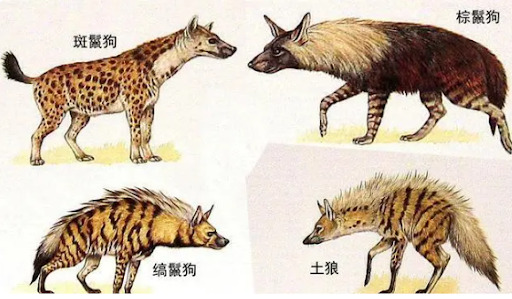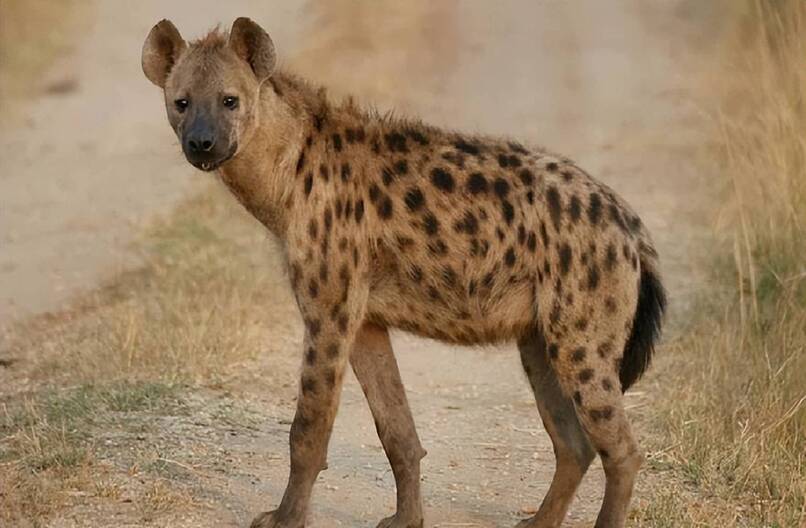Hyenas (Hyaenidae) are carnivorous mammals native to Africa and parts of Asia. Known for their powerful bite force and teamwork, hyenas are often misunderstood as mere scavengers. However, they are efficient hunters and play a vital role in maintaining the balance of ecosystems. This article explores the characteristics, behaviors, and ecological importance of hyenas.
Hyenas belong to a distinct family in the order Carnivora. Their classification is as follows:
Kingdom: Animalia
Phylum: Chordata
Class: Mammalia
Order: Carnivora
Family: Hyaenidae
Species:
Spotted Hyena (Crocuta crocuta)
Striped Hyena (Hyaena hyaena)
Brown Hyena (Parahyaena brunnea)
Aardwolf (Proteles cristata)

Appearance:
Hyenas are medium-sized animals, with a body length of 95–160 cm and weighing between 40–90 kg.
The spotted hyena is the largest species, with a broad head and powerful jaws.
Their coarse fur varies in color and pattern depending on the species.
Limb Structure:
Hyenas have longer forelimbs than hind limbs, giving their back a sloped appearance and aiding endurance running.
Unique Anatomy:
Hyenas have strong chewing muscles and specialized teeth for crushing bones, allowing them to extract nutrients from bone marrow.
Hyenas are social animals, especially the spotted hyena, which lives in female-dominated clans.
They are known for their high levels of cooperation and complex social behaviors.
Hyenas thrive in diverse habitats, including:
Savannas and Grasslands: Spotted hyenas are commonly found in the open plains of sub-Saharan Africa.
Desert Edges: Striped and brown hyenas inhabit arid regions and semi-deserts.
Mountains and Forests: Striped hyenas are also found in mountainous and forested areas of the Middle East and India.
Spotted Hyenas: Widely distributed across Africa.
Striped Hyenas: Found in North Africa, the Middle East, and South Asia.
Brown Hyenas: Confined to southern Africa's desert margins.
Aardwolves: Native to eastern and southern Africa, primarily feeding on termites.
Hyenas prefer open landscapes with clear visibility for spotting prey or scavenging opportunities. They often use caves and rock crevices as shelters.

Although hyenas are often labeled as scavengers, they are skilled hunters:
Group Hunting:
Spotted hyenas hunt in coordinated groups, targeting large prey like zebras and wildebeests.
Speed and Endurance:
Hyenas can run at speeds of up to 60 km/h and sustain long chases to exhaust their prey.
Flexibility:
Hyenas are opportunistic hunters, preying on smaller animals like rabbits and birds when needed.
Diverse Food Sources:
Hyenas are omnivorous, with a diet primarily consisting of meat, including bones and marrow.
Scavenging:
Hyenas are renowned scavengers, capable of consuming entire carcasses, including skin and bones.
Special Digestive Abilities:
Their strong stomach acids enable them to digest calcium and other nutrients from bones.
Matriarchal Society:
Spotted hyenas live in clans led by dominant females, who hold higher status than males.
Cooperative Roles:
Hyena clans work together to hunt, rear young, and defend territories.
Communication:
Hyenas use various vocalizations, including whoops and laughter-like calls, along with tail movements to communicate.
Reproductive Traits:
Hyenas breed year-round, with females giving birth to 1–4 cubs per litter.
Parental Care:
Cubs are raised in dens, with mothers providing care for up to a year.
Independence:
Young hyenas begin hunting around one year old and integrate into the clan.
Wild hyenas live an average of 10–15 years, while those in captivity can live up to 20 years.
Despite their strength, hyenas face threats from other predators:
Lions frequently compete with hyenas for food and may attack them.
Leopards:
Leopards occasionally prey on young hyenas or steal their kills.
Human Activities:
Habitat loss and poaching are significant threats to hyena populations.
Teamwork:
Hyenas rely on clan cooperation for protection and resource acquisition.
Speed and Vigilance:
Hyenas are highly alert and quick to evade threats.
Scavengers:
Hyenas clean up carcasses, preventing the spread of diseases and recycling nutrients.
Key Predators:
By hunting herbivores, hyenas help control populations and maintain ecological balance.
Hyenas play a role in regulating the numbers of medium-to-large herbivores, contributing to a balanced ecosystem.
Hyenas have complex relationships with predators and scavengers like lions, vultures, and wild dogs, involving both competition and mutual benefits.
African Folklore:
Hyenas are often associated with cunning and adaptability in African traditions.
Negative Perceptions:
In some myths and media, hyenas are portrayed as cowardly or villainous creatures, overshadowing their ecological importance.
Although most hyena species are listed as "Least Concern" by the IUCN, habitat destruction and human-wildlife conflict remain challenges.
Spotted Hyenas: Populations are stable in protected areas but declining elsewhere.
Striped Hyenas: Vulnerable to habitat fragmentation and hunting in some regions.
Protected Areas:
National parks and reserves in Africa, such as the Serengeti, are crucial for hyena conservation.
Community Engagement:
Education programs aim to reduce human-hyena conflicts and promote coexistence.
Hyenas are indispensable to savanna ecosystems, playing critical roles as both predators and scavengers. Their adaptability and social complexity make them fascinating and resilient survivors. Protecting hyenas and their habitats is vital for preserving the balance of nature and ensuring their legacy in the wild.
animal tags: hyenas
We created this article in conjunction with AI technology, then made sure it was fact-checked and edited by a Animals Top editor.